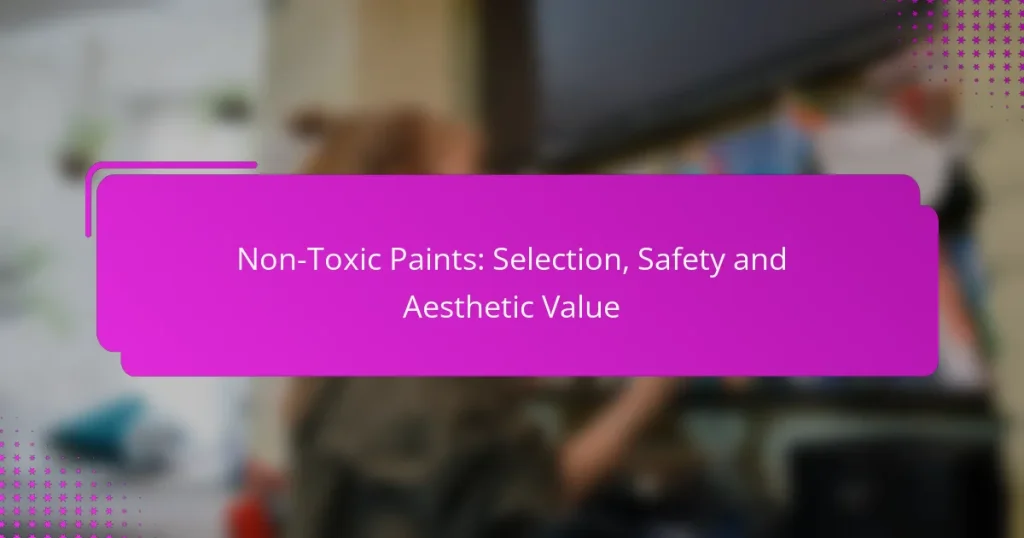Non-toxic paints are an excellent choice for creating a safe and aesthetically pleasing environment in your home. Formulated without harmful chemicals, they prioritize both health and environmental impact, making them ideal for spaces where children and pets spend time. When selecting non-toxic paints, it’s essential to consider certifications, ingredient lists, and finish options to ensure you meet your safety and design needs.

What are the best non-toxic paints for homes?
The best non-toxic paints for homes prioritize safety, environmental impact, and aesthetic appeal. These paints are formulated without harmful chemicals, making them suitable for indoor use, especially in spaces frequented by children and pets.
Benjamin Moore Natura
Benjamin Moore Natura is a premium non-toxic paint that meets stringent environmental standards. It is certified by Green Seal and has zero VOCs (volatile organic compounds), ensuring a safer indoor air quality. This paint offers excellent coverage and durability, making it a popular choice for residential projects.
When selecting Benjamin Moore Natura, consider its wide range of colors and finishes, which can enhance any room’s aesthetic. It is ideal for living spaces, bedrooms, and nurseries, where air quality is a priority.
Behr Premium Plus
Behr Premium Plus is another excellent option for non-toxic home painting. This paint is low in VOCs and provides a smooth finish that resists stains and mildew. It is available at major retailers, making it accessible for DIY enthusiasts.
This paint is suitable for both interior and exterior applications, offering versatility in home improvement projects. Behr Premium Plus is often praised for its affordability without compromising on quality.
ECOS Paints
ECOS Paints specializes in non-toxic, eco-friendly paints that are free from harmful chemicals. Their products are water-based and have no VOCs, making them safe for sensitive individuals. ECOS Paints also offers a wide variety of colors and finishes tailored to different surfaces.
Choosing ECOS Paints can be particularly beneficial for those with allergies or respiratory issues. Their commitment to sustainability and health makes them a trusted choice for environmentally conscious consumers.
Farrow & Ball Modern Emulsion
Farrow & Ball Modern Emulsion is known for its rich colors and luxurious finish. This paint is water-based and contains low levels of VOCs, making it a safer option for interior spaces. It provides excellent coverage and is suitable for high-traffic areas due to its durability.
While it may be on the pricier side, the aesthetic value and quality of Farrow & Ball Modern Emulsion can elevate the overall look of your home. It is particularly favored for its unique color palette and depth.
Clare Paint
Clare Paint offers a curated selection of non-toxic paints that are both stylish and safe. Their products are low in VOCs and designed for easy application, making them ideal for DIY projects. Clare Paint emphasizes a modern aesthetic with a focus on color trends.
With a user-friendly online shopping experience, Clare Paint allows customers to order samples and visualize colors in their spaces. This brand is perfect for those looking to refresh their home with minimal environmental impact.

How do I choose non-toxic paints?
Choosing non-toxic paints involves looking for specific certifications, reviewing ingredient lists, and considering the finish options. These steps ensure that the paint is safe for both health and the environment while meeting your aesthetic needs.
Check for certifications
Certifications are key indicators of a paint’s non-toxic properties. Look for labels such as Green Seal, GREENGUARD Gold, or the EPA’s Safer Choice, which signify that the product meets strict safety standards. These certifications help you identify paints that minimize harmful emissions and are safer for indoor use.
When shopping, check the packaging for these certifications, as they can vary by region. In Europe, look for the EU Ecolabel, which also indicates environmentally friendly products.
Review ingredient lists
Thoroughly reviewing the ingredient list is crucial in selecting non-toxic paints. Avoid paints that contain volatile organic compounds (VOCs), heavy metals, or other harmful additives. Many non-toxic options are now available that use natural pigments and binders, making them safer alternatives.
Familiarize yourself with common harmful ingredients, such as formaldehyde and phthalates, and look for paints that explicitly state they are free from these substances. This practice helps ensure a healthier indoor environment.
Consider finish options
The finish of the paint can impact both aesthetics and safety. Non-toxic paints come in various finishes, including matte, eggshell, and satin. Each finish has different durability and washability, so consider where the paint will be applied.
For high-traffic areas, a satin or semi-gloss finish may be more practical due to its washability, while a matte finish can be ideal for low-traffic spaces. Always confirm that the finish you choose is compatible with non-toxic standards to maintain safety and performance.

What are the safety benefits of non-toxic paints?
Non-toxic paints offer significant safety benefits, primarily by reducing harmful chemical exposure in indoor environments. These paints are formulated to minimize or eliminate volatile organic compounds (VOCs), making them a healthier choice for homes and workplaces.
Reduced VOC emissions
Non-toxic paints typically have low to zero VOC emissions, which means they release fewer harmful chemicals into the air. This reduction is crucial, as VOCs can contribute to various health issues, including headaches and respiratory problems.
When selecting non-toxic paints, look for products labeled as low-VOC or VOC-free. These paints often comply with strict environmental standards, ensuring a safer application process and a healthier living space.
Safer for children and pets
Non-toxic paints are especially important in homes with children and pets, as they are less likely to cause adverse health effects. Traditional paints can contain hazardous substances that may pose risks if ingested or inhaled.
Choosing non-toxic options helps create a safer environment for your family. Always check for certifications or labels indicating that the paint is safe for use around children and animals.
Improved indoor air quality
Using non-toxic paints significantly enhances indoor air quality by minimizing the release of harmful chemicals. This improvement is vital for maintaining a healthy living environment, especially in spaces where people spend a lot of time.
To further improve air quality, consider using non-toxic paints in combination with proper ventilation during and after application. This practice helps to dissipate any remaining odors and ensures a fresher atmosphere in your home.

How do non-toxic paints compare in aesthetic value?
Non-toxic paints can offer comparable aesthetic value to traditional paints, with a wide range of colors and finishes available. Their formulation allows for vibrant hues and appealing textures, making them suitable for various design preferences.
Color variety and vibrancy
Non-toxic paints are available in a broad spectrum of colors, often matching or exceeding the vibrancy of conventional options. Many brands utilize natural pigments that provide rich tones without harmful chemicals. When selecting non-toxic paints, look for those labeled as low-VOC or zero-VOC to ensure both color quality and safety.
Some popular non-toxic paint brands offer custom color mixing, allowing homeowners to achieve their desired shades. This flexibility ensures that aesthetic preferences are met without compromising health standards.
Durability and finish options
While non-toxic paints can be durable, their longevity may vary based on the specific formulation and application. Many non-toxic options are designed to resist fading and wear, making them suitable for high-traffic areas. However, it’s essential to choose the right finish—such as matte, satin, or gloss—based on the intended use of the space.
Consider that some non-toxic paints may require more frequent touch-ups compared to traditional paints, especially in areas exposed to moisture or heavy use. Always check manufacturer guidelines for the best practices in application and maintenance.
Eco-friendly design appeal
The aesthetic value of non-toxic paints extends beyond color and finish; they contribute to an eco-friendly design ethos. Using sustainable materials and processes, these paints appeal to environmentally conscious consumers looking to create healthy living spaces. Incorporating non-toxic paints can enhance the overall design narrative of a home.
Additionally, many non-toxic paints are free from harmful solvents and chemicals, which can improve indoor air quality. This aspect not only benefits the environment but also promotes a healthier home for occupants, making it an appealing choice for families and individuals alike.

What are the costs associated with non-toxic paints?
The costs associated with non-toxic paints can vary significantly based on the brand, type, and specific formulations. Generally, these paints may be more expensive upfront compared to traditional options, but they offer benefits that can offset these initial costs over time.
Price range per gallon
The price of non-toxic paints typically ranges from around $30 to $70 per gallon, depending on the brand and specific characteristics. Premium brands or specialized formulations, such as those that are zero-VOC or made from natural ingredients, may cost even more.
When budgeting for a painting project, consider the total area to be painted and calculate how many gallons you will need. It’s wise to compare prices across different retailers and look for sales or discounts to minimize expenses.
Long-term savings on health
Investing in non-toxic paints can lead to long-term savings on health-related costs. By reducing exposure to harmful chemicals, you may lower the risk of respiratory issues, allergies, and other health problems associated with conventional paints.
Additionally, healthier indoor air quality can result in fewer medical visits and less spending on treatments for related ailments. Over time, the benefits of using non-toxic paints can outweigh the higher initial purchase price, making them a financially sound choice for health-conscious consumers.


